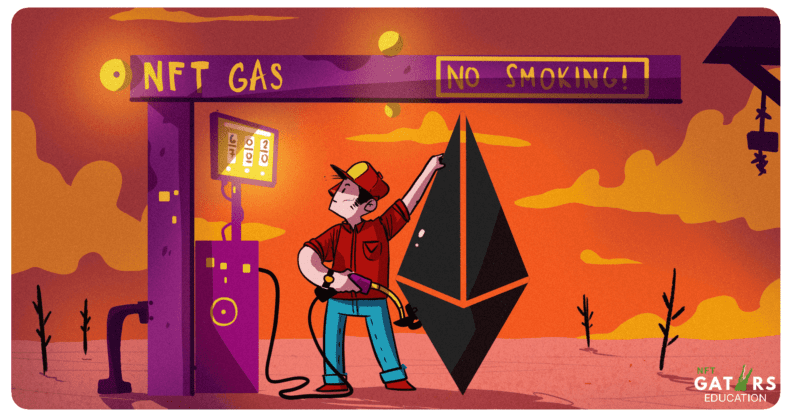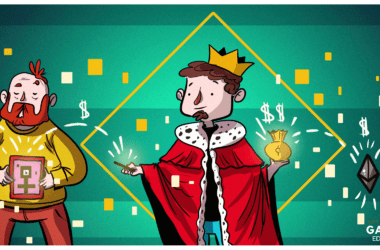Last Updated on February 4, 2023
The vast majority of NFTs are built on the Ethereum blockchain using the ERC-721 standard, mainly due to the fact that Ethereum is decentralized and one of the most popular (and secure) networks in the cryptocurrency space.
While NFTs sales are generating hundreds of millions of dollars worth of sales each month, one often misunderstood cost to buyers is the gas fee, which has caused some people to have to fork out over $200 for an NFT valued at $30. This is a problem that is becoming more apparent in the NFT industry, as both buyers, sellers, and artists feel as though there are multiple levels of hidden fees that reduce their profit margins and make it harder for them to make a profit. So how does that work exactly? Let us break it down for you.
What are Gas Fees?
Gas is the term used to refer to the fee that users incur when interacting or transacting with the Ethereum blockchain. Gas is typically priced in small fractions of the ETH, which is the cryptocurrency of the Ethereum platform. These small fractions of ETH are commonly referred to as gwei and are some of its smallest denominations (similar to satoshis and Bitcoin).
This gas is used to pay for the computational power required to mine new ETH tokens, which keeps the Ethereum blockchain functioning as it does. As such, the gas fee correlates to the amount of computational power required to execute any given transaction, such as sending ERC-20 tokens, interacting with a contract, sending ETH, or doing anything else on the blockchain.
It’s vital to understand that regardless of whether or not your transaction succeeds or fails, you are obliged to pay a gas fee. Even if the transaction fails, miners must verify and execute it, which requires computational power. Therefore, you need to pay for that computation the same way you would for a successful transaction.
What are typical gas fees when minting and sending NFTs?
When it comes to NFTs, there are only two instances where you will have to pay a gas fee, and that is when first minting a new NFT and transferring an NFT to another wallet.
When minting an NFT, you must pay a fee to create the smart contract on the Ethereum network. This contract will hold all of the metadata that allows the NFT to possess unique identifiers, permanently etching itself onto the transparent, public ledger. This process can cost anywhere from $30 to a few hundred, depending on how congested the network is.
You must also pay when transferring an NFT to another wallet, although this is usually much cheaper since a simple token transfer requires far less gwei. You can often send an NFT for a little as $1-2.
One of the biggest issues with the Ethereum network is that gas fees can become outrageously expensive during busy periods. This is because the blockchain grows increasingly congested as more people utilize it. Since the number of transactions included in each new block added to the Ethereum blockchain is limited, miners are incentivized to accept transactions at higher gas prices due to supply and demand, which means you will need to pay more if your transaction is to be successful.
Here is the gas fee formula
Two elements impact the cost of any given transaction on the Ethereum network:
- The gas price at the time of the transaction
- The amount of gas required for a particular transaction
Gas units (limit) * Gas price per unit (in gwei) = Gas fee
To calculate the gas price, you need to know how much gas (gwei) is required for the transaction. The minimum amount needed for the simplest transaction on the Ethereum network, for example, moving ETH between two addresses, is 21,000 units. More complex transactions involving smart contracts such as buying other tokens or staking your tokens require a lot more gas.
The second part of the equation requires you to enter your gas limit, the maximum amount of gas you are willing to use on any given transaction (any unspent gas will be returned to you). Here is an example of that in action:
Since the TX will require 21,000 units, that shall be our limit. The current gas price is 66 gwei, therefore:
21,000 * 66 gwei = 1386000 gwei
1386000 gwei is 0.001020 ETH, which at current rates is around $4.20.
However, rather than work it out for yourself, there are plenty of online tools that do the hard work for you, such as Etherscan’s gas tracker. These tools give you an estimate of the gas fee for a variety of different transaction types and network interactions, which can help you get a better understanding of the costs of interacting with the Ethereum blockchain.
How to avoid high NFT gas fees
Whether you are an NFT artist or an investor looking to turn a profit, you must understand how to avoid high gas fees if you want to save yourself some money. Here are a few tips to help you
- Plan ahead of time to avoid congestion
- Use Etherscan’s gas tool to estimate the cost of transfers and interactions on the network
- Opt for slower transactions
- Use applications that offer gas rebates
FAQ
Why are NFT gas fees necessary?
NFT gas fees are necessary to ensure that transactions involving NFTs are processed quickly and efficiently by the Ethereum network.
How are NFT gas fees determined?
NFT gas fees are determined by supply and demand for processing power on the Ethereum network. This guide contains a calculation formula, check it out.
How do I pay NFT gas fees?
NFT gas fees are typically paid using Ethereum (ETH), and the fees are deducted from your Ethereum wallet balance. It is important to have sufficient funds in your wallet to cover the gas fees in order to ensure successful processing of your NFT transactions.





